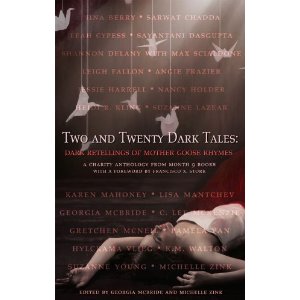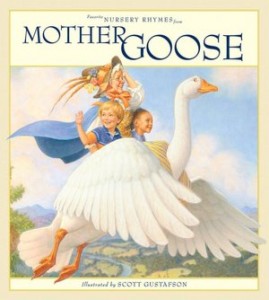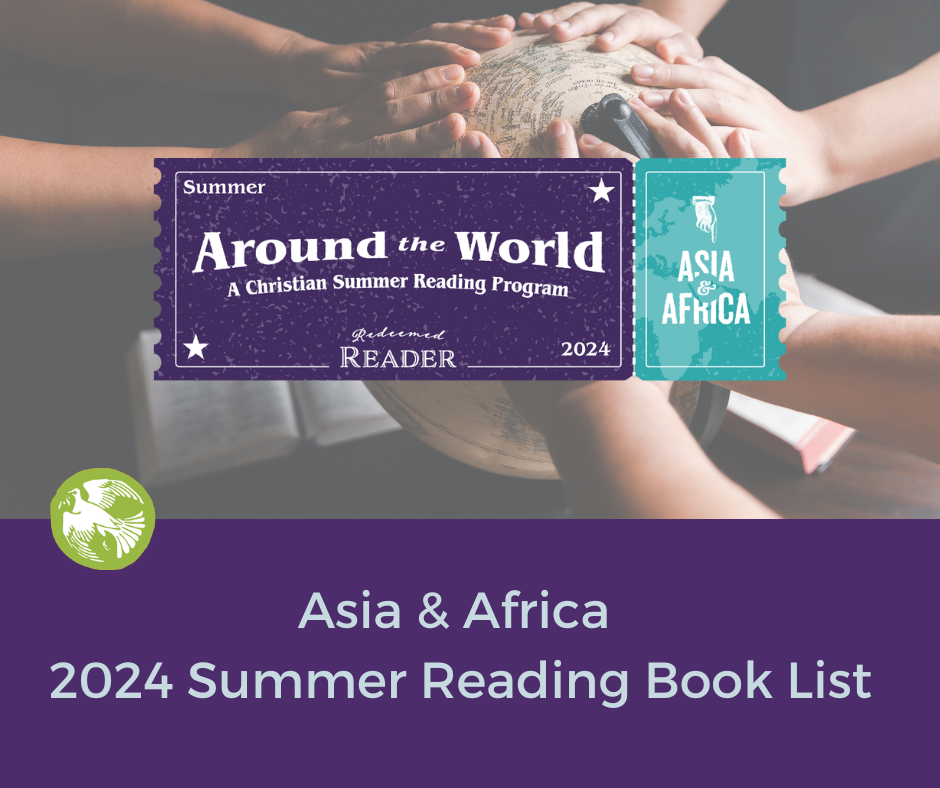We have something to look forward to this fall: a new publishing house called Month9Books which will specialize in fantasy fiction. First title, due in October, is Two and Twenty Dark Tales: Dark Retellings of Mother Goose Rhymes.
Besides the annoying redundance, the title is an obvious rejoinder to that Wall Street Journal column by Meghan Cox Gurdon a year and a half ago: “Darkness too Visible.” Ms. Gurdon’s article was an inquiry into the grim trend of Young Adult fiction, and proved to be a lot more than the author bargained for. Most of the outrage subsequently directed at Ms. Gurdon suggested that she was naïve: didn’t she know what tough challenges teens faced?
 Georgia McBride, founder of YALITCHAT.com, was one of the many who responded. “. . . I began to think about a Mother Goose book that my sister gave me when my daughter was born eight years ago. Reading it, I always get caught up in the darker parts of the rhymes. And it occurred to me that there are things like servitude, murder, and kidnapping in those rhymes—which is not comforting. But you don’t hear people complain about Mother Goose, or about some of the dark sides of Disney stories. Somehow these are accepted by our culture, yet when we consider the dark aspect of YA literature, we start to put the brakes on.” That gave her an idea: what about a YA anthology of “dark and twisted retellings of Mother Goose rhymes”? “I thought it would be really cool if done in a positive way.”
Georgia McBride, founder of YALITCHAT.com, was one of the many who responded. “. . . I began to think about a Mother Goose book that my sister gave me when my daughter was born eight years ago. Reading it, I always get caught up in the darker parts of the rhymes. And it occurred to me that there are things like servitude, murder, and kidnapping in those rhymes—which is not comforting. But you don’t hear people complain about Mother Goose, or about some of the dark sides of Disney stories. Somehow these are accepted by our culture, yet when we consider the dark aspect of YA literature, we start to put the brakes on.” That gave her an idea: what about a YA anthology of “dark and twisted retellings of Mother Goose rhymes”? “I thought it would be really cool if done in a positive way.”
Here’s Ms. McBride’s take on Humpty Dumpty, minus the rhyme: “He’s been bullied, and has had enough. He posts a letter online that he’s going to commit suicide. All the people who tried to help him just weren’t able to. And my short story about Little Miss Muffet is a sick and twisted version of the rhyme—with lots of spiders.” I guess that’s what she means by positive.
I still have my 1933 edition of Watty Piper, and of course I read many versions of many rhymes to my children, and I’m still not sure what she means about all the servitude, murder, and kidnapping. As a child, I remember feeling sorry for Jack after he broke his crown (Jill is implicated in further verses), but not too bad about Humpty Dumpty. Suicidal tendencies notwithstanding, he was an egg.
The Two and Twenty Dark Tales is probably supposed to be taken in good fun, and that’s swell—I don’t have to read it. It’s Georgia McBride’s take on traditional nursery rhymes that seems odd. “Traditional” means they originated in a world that most of us would consider dark—a world without anesthetics, as C.S. Lewis remarked, not to mention antibiotics, aspirin, and air conditioning. The rhymes were not supposed to rub children’s little faces in real life’s harsh realities—real life did that. Primarily they were intended to entertain, instruct, and lull to sleep, as well as serve as an introduction to the notion of meter and rhyme. But on a deeper level they did more than that: nursery rhymes provided a way of taking ordinary experiences and making them epic. I mentioned Thomas Howard’s Chance or the Dance? in an earlier post about poetry. Howard uses a Mother Goose rhyme—surely the lowest and most primitive form of poetry—to show how humans impose a “form” on daily existence, through little ceremonies and rituals: “One foot up, the other foot down;/That’s the way to London town.”
I like the way he says it:
It is imagination that plants in us in the first place the idea that the turning [i.e., the routine one-foot-up-one-foot-down] may be robbing us of our only chance to live, unless we find out that at the center of every turning there is a still point, and we move toward that point in whose stillness there are held all the turnings that seem so helter-skelter to us. . . [Poetry] addresses our imagination and, with everything that is at its service, it tries to beguile us into the intense awareness of experience . . . and to return us to life with the awareness that it is packed with glory . . .
The form of order many authors like to impose today is political: even for nursery rhymes. I don’t want to read too much into Ms. McBride’s take on her daughter’s Mother Goose book, but it does seem that she’s making a point about the socio-economic conditions described therein. If everyday nursery rhymes have their dark side (she’s saying), why do nervous nellies get their drawers in a twist about “dark” YA fiction?
Leaving the YA issue aside for now, the dark side of Mother Goose is irrelevant. We hear how many of the rhymes have grim origins: “Ring-a-Round-a-Rosie” supposedly references the Black Plague (though there’s some doubt about that), “Mary Mary Quite Contrary” was inspired by Bloody Mary Tudor and her persecution of Protestants, and so on. But by the time Mother Goose takes up residence in the nursery, none of that matters. Little rhymes, joyfully chanted, trivial in subject but large in form, present a way to think about what life is: just a series of events, or “conditions” that need to be fixed, or something greater? Mother Goose shows little ones that order is possible, enjoyable, and to be desired.
If you’re in the market for a basic Mother Goose book, the top sellers are these:
Mother Goose, illustrated by Gyo Fujikawa.
Favorite Nursery Rhymes from Mother Goose, illustrated by Scott Gustafson.
My Very First Mother Goose, by Iona Opie and Rosemary Wells.
Mary Englebright’s Mother Goose: One Hundred Best-Loved Verses, illustrated obviously by Mary Englebright.
It’s been a long time since I was asked to read nursery rhymes, so I haven’t browsed these books, but they look like a good place to stop if you’re in the market. Buy or borrow a good Mother Goose book, curl up with a favorite child, and read some rhymes. They are a legacy of being human.
As for Ms. McBride’s comment about fairy tales a la Disney, that’s a subject in itself. Come back on Friday!
Let us know your Mother Goose favorites! And for our take on the Meg Gurden controversy, see Turn on the Light, The Lord Saves, and The Use and Abuse of Youth Literature.
Stay Up to Date!
Get the information you need to make wise choices about books for your children and teens.
Our weekly newsletter includes our latest reviews, related links from around the web, a featured book list, book trivia, and more. We never sell your information. You may unsubscribe at any time.
Support our writers and help keep Redeemed Reader ad-free by joining the Redeemed Reader Fellowship.
Stay Up to Date!
Get the information you need to make wise choices about books for your children and teens.
Our weekly newsletter includes our latest reviews, related links from around the web, a featured book list, book trivia, and more. We never sell your information. You may unsubscribe at any time.
We'd love to hear from you!
Our comments are now limited to our members (both Silver and Golden Key). Members, you just need to log in with your normal log-in credentials!
Not a member yet? You can join the Silver Key ($2.99/month) for a free 2-week trial. Cancel at any time. Find out more about membership here.
4 Comments
Leave a Comment
You must be logged in to post a comment.




Meg Gurdon must be proud to have inspired an entire book. Looking forward to hearing the rest of this dark tale on Friday!
Honestly, I never thought of Mother Goose rhymes as dark. They were cute, simple little rhymes that, as a child, I never completely understood. I was quite literal; when Jack broke his crown, I thought it was an actual crown made of gold.
I’m undecided on the darkness debate. Personally, I won’t read books with too much darkness in them. Books that deal graphically with murder, rape, and drug abuse are just too intense for my taste. But books that deal with heartrending events that have a positive outcome? I love those. I just can’t stand books that take a young person into horribly dark places and then leave him there. I don’t want to believe that that is what the real world is like; I want to think there’s a good deal more hope available.
Danielle, I agree with you. I don’t think the MG rhymes were meant to torture anyone. And I agree that some folks can be hyper-sensitive to dark or offensive material in books. See Huckleberry Finn or To Kill A Mockingbird. But I am concerned that many authors seem to be running off the cliff in the other direction, too. See our Fifty Shades discussion. Thanks for chiming in in such a thoughtful way!
Finally catching up on my Google reader!
Mother Goose Faves:
Definitely the Gyo Fujikawa one mentioned! A classic for good reason
I also like Leo and Diane Dillon’s Mother Goose Numbers on the Loose, although it’s a bit bizarre in places. Still, it’s a really cool book.
There are two Rosemary Wells/Iona Opie collaborations, both good. Tomie DePaola has a couple of small collections out, too.
For more “classic” feels: Tasha Tudor and Kate Greenaway both illustrated/compiled Mother Goose rhymes.